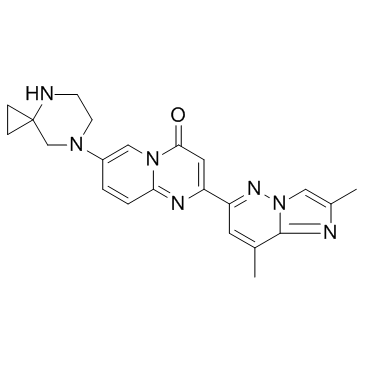| Cas No.: | 1825352-65-5 |
| Chemical Name: | 7-(4,7-diazaspiro[2.5]octan-7-yl)-2-(2,8-dimethylimidazo[1,2-b]pyridazin-6-yl)-4H-pyrido[1,2-a]pyrimidin-4-one |
| Synonyms: | RG7916;RG-7916;RO7034067 |
| SMILES: | C12C=CC(N3CC4(CC4)NCC3)=CN1C(=O)C=C(C1=NN3C=C(C)N=C3C(C)=C1)N=2 |
| Formula: | C18H29N3O3 |
| M.Wt: | 401.474 |
| Purity: | >98% |
| Sotrage: | 2 years -20°C Powder, 2 weeks 4°C in DMSO, 6 months -80°C in DMSO |
| Description: | Risdiplam is an orally administered, centrally and peripherally distributed SMN2 pre-mRNA splicing modifier that increases survival motor neuron (SMN) protein levels. |
| Target: | SMN2 |
| In Vitro: | Risdiplam modulates SMN2 pre-mRNA splicing towards the production of full-length SMN2 mRNA and increases SMN protein levels. Risdiplam is a modifier of SMN2 splicing, leading to an increase in SMN2 full length transcript and thus functional SMN protein. Spinal muscular atrophy (SMA) type I remains the most common genetic disease resulting in death in infancy. Characterized by progressive motor and respiratory muscle weakness, this autosomal recessive neuromuscular disorder is caused by low levels of the survival motor neuron protein (SMN) due to inactivating bi-allelic deletions and other disabling mutations in the survival motor neuron 1 (SMN1) gene[1]. |
| References: | [1]. Poirier A, et al. Risdiplam distributes and increases SMN protein in both the central nervous system and peripheral organs. Pharmacol Res Perspect. 2018 Nov 29;6(6):e00447. |

 DC Chemicals' products qualify for U.S. tariff exemptions. We guarantee no price increases due to customs duties and maintain stable supply, continuing to deliver reliable research solutions to our American clients.
DC Chemicals' products qualify for U.S. tariff exemptions. We guarantee no price increases due to customs duties and maintain stable supply, continuing to deliver reliable research solutions to our American clients.





















